Mirax
The name Mirax was also used by an unknown French company for a multifocal viewfinder.

|
| Mirax-B, intermediate (type 8), no.540524, Focabell and Supreme lens head on a Nikon S. Picture courtesy of eBayer toolchest. (Image rights) |
The Mirax is a reflex housing with interchangeable finders, made from 1952 by Orion Seiki, later Orion Camera then Miranda Camera. It formed a system with the Focabell bellows and Supreme lenses, and can be considered the first step in the development of the Miranda SLR cameras. The Mirroscope and Mirabox are name variants of the Mirax.
Contents
General description
The Mirax main mirror box has a black crinkle finish. The viewing screen, placed at the top of the mirror box, has a condenser lens with a convex upper surface. The interchangeable viewfinder is held by two pins on the right side, and locked by a latch on the left side, whose shape varied with time (see below). The standard viewfinder is an all chrome loupe finder shaped as a chimney, with a magnifying eyelens at the top. (It was called chest-level finder in the original documents in English language.) The release button is on the right side, and can be coupled to the camera body via a snap release or a double cable release (see details below). There is a tripod thread underneath the mirror box.
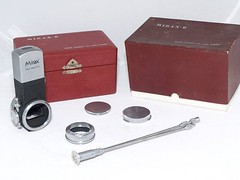  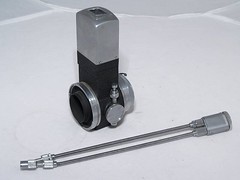
|
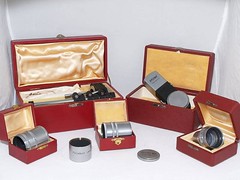  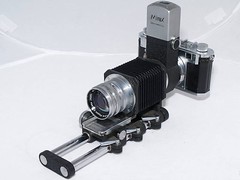
|
| Mirax-B, early (type 6), no.531147, with Focabell bellows and Supreme 10.5cm f/2.8 lens head or Nikkor 5cm f/1.4. Pictures courtesy of Igor's Camera Exchange. (Image rights) |
The front part has a 44mm female screw mount, of which it is the earliest occurrence, before it appeared on the Phoenix SLR prototype and later Miranda cameras. Later versions also have an external four-lug bayonet mount, as on the Miranda SLR cameras; it appeared on the Mirax while the Phoenix was under development, a few months before it was announced to the press.

|
| Mirax-A, rear mount adjustment. From Shashin Kōgyō May 1953. (Image rights) |
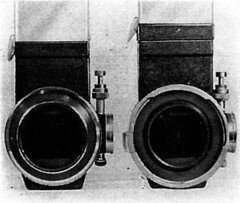
|
| Mirax-A and Mirax-B, early (type 2 or 3). From the Mirax user manual. (Image rights) |
Two versions of the Mirax were sold, differing by the rear mount. The Mirax-A (#500A)[1] fits Leica screw mount cameras. It has an adjustable rear mount, which can be rotated so that the reflex housing always stands upright, whatever the adjustment of the camera body.
The Mirax-B (#500B)[1] has a Contax or Nikon rangefinder mount. These two mounts only differ by the rangefinder adjustment, causing no physical difference on the reflex housing. An original price list nonetheless distinguishes the "Mirax-BC" for Contax and the "Mirax-Bn" for Nikon,[2] but this is either a mistake or a distinction based on the release linkages, because of the different location and shape of the shutter button on the camera bodies. The Mirax-B has the same body casting as the Mirax-A, but has a 9mm insert between the casting and the viewing screen, raising the latter to compensate for the longer film-to-flange register.
Evolution
The classification presented below is based on the analysis of various surviving examples. The type numbers used in this article were not officially used by the Orion or Miranda companies, but reflect the current state of research.[3]
Mirax, early period
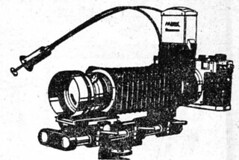
|

| |
| Mirax-A, early (type 3 or 4). From Asahi Camera September 1953. (Image rights) | Mirax-A, early (type 3, 4 or 5). From Asahi Camera November 1953. (Image rights) |
The examples of the early period (types 1 to 7), from c.1952 to c.1954, have the early type of mirror actuator. There is a release button above the mirror mechanism, surrounded by a male thread, and another thread underneath, allowing to attach a cable release connected to the camera's shutter button. On the Mirax-A, the adjustment of the rear mount orientation is provided by three set screws.
Most of these early examples have the 44mm female screw mount only (on types 1 to 6), and have a loupe finder made of two main parts, attached together by four visible screws (on types 1 to 5).
The earliest examples produced (types 1 to 3) have no serial number, and no inscription whatever on the rear mount. The adjustable rear mount has a minor peculiarity: the externally visible set screws are just decorative screws, capping the holes for the actual set screws retaining the rotating mount.[4] When trying to adjust the rear mount on these types, the owner should be careful not to apply excessive force after loosening the outer screws.
Type 1 has a small clip to attach the viewfinder. The loupe finder is inscribed Orion Mirax I at the front. It has square corners, and this causes some incompatibility: the finder for type 1 fits most of the later mirror boxes, whereas finders for later types — with slightly rounded corners — do not fit onto the type 1 mirror box. The Mirax type 1 is extremely rare, with only two examples confirmed so far (both are Mirax-A), in addition to the very early example pictured in the June 1952 issue of Shashin Kōgyō.
 
|
| Loupe finders: first and second model. From Shashin Kōgyō June 1952 and Asahi Camera November 1953. (Image rights) |
Type 2 differs by its sturdier large clip to attach the finder. Its loupe finder is also inscribed Orion Mirax I, but has slightly rounded corners. (All subsequent finder types are compatible between them.) Type 3 has the second version of the loupe finder, inscribed Mirax and Orion Camera Co. in small characters.
Type 4 differs by the introduction of a serial number on the rear mount, together with the words Orion Camera Co. and Made in Japan. The arrangement of the rear mount is more straightforward than on earlier types, with three set screws that reach all the way through to the underlying flange, to lock the orientation.
The only confirmed serial number for type 4 is 530132, in a sequence that certainly started at 530000. It is not known if serial numbers in the same sequence were already assigned to the previous examples (types 1 to 3) or not. The first two digits of the serial number look like they might indicate the year of production but this is misleading.
Type 5 has a knob instead of a clip to attach the viewfinder; this knob would continue on all the subsequent examples. Serial numbers for this type are known from 530626 to 530971.
Type 6 has the third version of the loupe finder, made of a single part, with the same Mirax and Orion Camera Co. markings. It is known from a single example of the Mirax-B, with serial number 531147. No other example is known in the 531xxx range, which was perhaps specific to the Mirax-B.
Type 7 differs by the addition of the external bayonet mount outside the front screw mount. (A utility model concerning the bayonet was applied for by the Orion company.)[5] Serial numbers are known from 530991 to 540101. The sequence was certainly reset at 540000 at some point, but it is unclear if there was an overlap with the production of type 6.
Mirroscope, for export
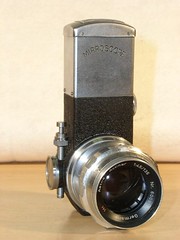 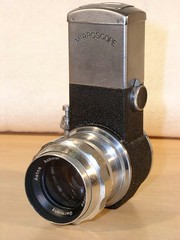  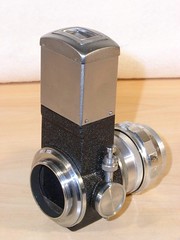
|
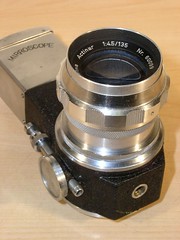 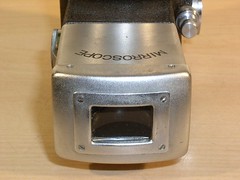
|
| Mirroscope no.53000. Pictures courtesy of Brooklyn Camera. (Image rights) The Aetna Actinar 135/4.5 no.60099 lens head has a Leica screw mount and a focusing helicoid, and is attached via an adapter. |
The Mirroscope is a name variant of the Mirax type 5, from which it differs only by the name MIRROSCOPE engraved at the front of the loupe finder, following a curved line. It sometimes comes with a specific eye-level finder (see below).
Unlike other Orion products, the Mirroscope has a five-digit serial number, in the 53xxx range. The example pictured above has no.53000, and is presumably the first produced. Other numbers are known up to 53542. The Mirroscope user manual mentions a model A in Leica mount and a model B for Contax and Nikon, but no actual example of the latter has yet been observed.
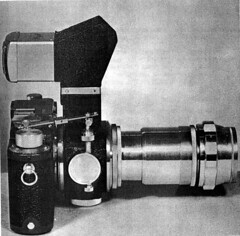
|
| The Focus reflex housing (FRH-1). From a catalogue by The Focus. (Image rights) |
 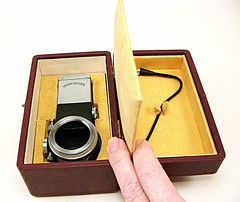
|
| Mirroscope and Interstate jewel case. Pictures courtesy of Roger Reinke. (Image rights) |
Original boxes for the Mirroscope are either marked Interstate PHOTO SUPPLY CORP. or AETNA OPTIX. This certainly indicates that the model was sold in the United States both by Interstate and Aetna — this was perhaps Orion Seiki's earliest export attempt.
The device was also sold by The Focus as part of a set called Variflex comprising a bellows and an Actinar 135/4.5 lens head,[6] or alone under the name The Focus reflex housing (FRH-1)[7] — see the original documents below. It seems that the examples sold by The Focus have MIRROSCOPE markings, and are indistinguishable from the Mirroscope.
Mirabox name variant
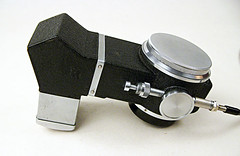
|

|

| |
    
| |
| Mirabox no.530932, with prism finder. The bottom thread attachment for the cable release has been modified. Pictures courtesy of Roger Reinke. (Image rights) | |
The Mirabox is another name variant of the Mirax type 5, which certainly came after the Mirroscope. It was sold in Japan by Summit Shōkai at some period (see the original documents below), and was perhaps available in other companies as well. It differs only by the straight Mirabox engraving in front of the loupe finder (or Mira box in two lines on the prism finder). The only serial numbers confirmed so far are 53661, coming immediately after the Mirroscope batch, and 530932, mixed with Mirax numbers. As for the Mirroscope, at least one original document mentions a Mirabox A and a Mirabox B, but no example of the latter has yet been observed.
Mirax, intermediate period

|
| Mirax-A, intermediate (type 8). From the June 1955 special issue of Photo Art. (Image rights) |
The examples of the intermediate period, made in 1954–5,[8] have a new type of release button and mirror mechanism. All belong to type 8, and have Orion Camera Co. markings. Serial numbers for type 8 are known from 540240 to 540524.
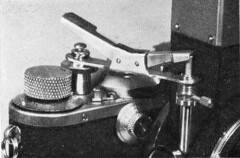
|
| Mirax-A, intermediate (type 8), with the newer snap release. From Shashin Kōgyō May 1954. (Image rights) |
The newer release button is connected to the mirror mechanism by a long hollow chrome rod, which is even longer on the Mirax-B. It has a small bayonet attachment, moved by a lever on the side, receiving the newer articulated "snap release" (see below). The design of the mirror actuator and snap release was perhaps modified to insure that the mirror is always raised before the shutter is tripped. There is also a male thread around the base of the release button, for a cable attachment; the underside thread is no longer present.
Other minor changes were introduced at the same time. On the Mirax-A, the set screws used to adjust the orientation of the mirror box were replaced by a single traversing screw, visible underneath the mirror actuation mechanism. (A utility model concerning this device was applied for by the Orion company.)[5] Finally, the viewfinder attachment holes were made oval instead of round, allowing for some variation in the position of the attachment pins on the right side of the mirror box.
 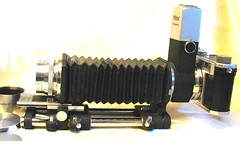
|
| Mirax-B, intermediate (type 8), no.540524, Focabell and Supreme 10.5cm f/2.8 lens head on a Nikon S. Pictures courtesy of eBayer toolchest. (Image rights) |
Mirax, late period
Examples of the late period, from 1955 to the late 1950s, have a black fairing over the connection between the release button and mirror mechanism.
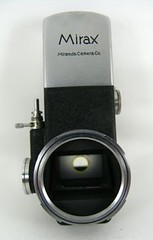 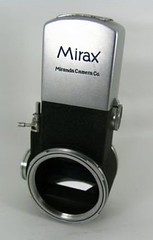  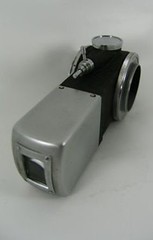
|
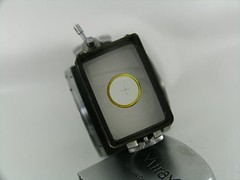 
|
| Mirax-A, late (type 10), Miranda Camera markings. The focusing screen with a clear central spot and a hand-drawn crosshairs is probably not original. Pictures courtesy of eBayer fargo02. (Image rights) |
Type 9 has the Orion Camera Co. markings on the loupe finder and rear mount. Serial numbers are known from 540464 to 541383, partly overlapping those of type 8. Type 10 has Miranda Camera Co. markings instead, and is known from 541061 to 542239, again overlapping the production of type 9 by a few hundred units. Type 10–2 corresponds to the final examples of the Mirax-A, which have an interruption in the rear Leica thread — examples are known from 542570 to 542758.
 
|
| Mirax-A, late (type 10-2), no.542758, interrupted Leica thread. Pictures by Sunil Gopalan. (Image rights) |
At least one example of the Mirax-A type 10 has been observed with an intermediate part between the mirror box and loupe finder, in black crinkle finish, making the device taller.[9] This was perhaps an aftermarket modification, for an unknown purpose.
Other viewfinders
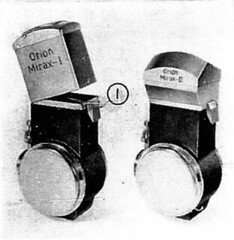
|
| First loupe and prism finders. From the Mirax user manual. (Image rights) |
In addition to the loupe finder fitted as standard, eye-level and waist-level finders were also available. The company's expertise on interchangeable pentaprism finders paved the way to the Phoenix SLR prototype and to the subsequent Miranda cameras.
Eye-level
The first prism finder was announced at the very beginning, in mid-1952,[10] and might be the first Japanese pentaprism finder. The item has an all chrome finish, and is inscribed Orion Mirax–II at the front (see below). It gives a laterally corrected image.[11] It is quite high and practically does not protrude on the rear of the Mirax housing, making it inconvenient to position an eye at the eyepiece. It was abandoned for that reason, and research was conducted on a new optical design, which would be more comfortable to use.[12] This early prism finder was perhaps never commercially sold, and no surviving example has been observed yet, though pictures appear in various original documents.[13]
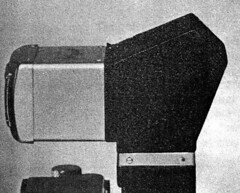
|
| The Focus eyelevel finder (EL-5). From a catalogue by The Focus. (Image rights) |
The Mirroscope prism finder contains a straight (non roof) pentaprism, giving a laterally reversed image. The pentaprism casing is covered with black crinkle paint, and the eyepiece is made of two chrome parts, akin to the loupe finder. The name MIRROSCOPE is engraved above the longer part of the eyepiece. This finder was made for the Mirroscope only, and was certainly never sold in Japan. It was perhaps designed when the company was researching a way to extend the eyepiece to the rear, after the first type of prism finder was found unsatisfactory.[14]
 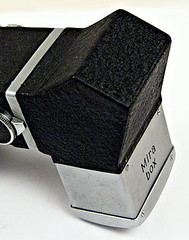
|
| Mirabox prism finder. Pictures courtesy of Roger Reinke. (Image rights) |
The same device was also sold by The Focus under the name eyelevel finder (EL-5), apparently with the same MIRROSCOPE engraving (see below).[7] The Mirabox prism finder is exactly similar, except for the Mira box marking (split in two lines).[15] It was made for the Mirabox reflex housing.
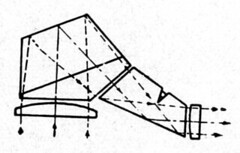
|
| Scheme of the new prism finder. From Shashin Kōgyō May 1954. (Image rights) |
The new prism finder is comparatively lower and protrudes to the rear, placing the eyepiece at an ideal position, right above the camera's viewfinder. It has an all new optical design, resulting from the research started in 1953. (Similar prism finders would appear on the Visoflex only later.)
An all black prototype is pictured in the May 1954 issue of Shashin Kōgyō.[16] It has a rounded shape, and was certainly never sold.
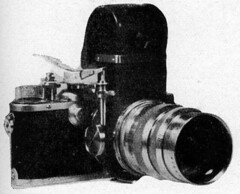 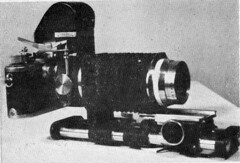 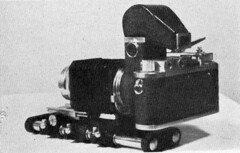
|
| Prototype prism finder on a Mirax-A. From Shashin Kōgyō May 1954. (Image rights) |
The definitive casing has many facets and sharp edges. The front facet is inscribed Mirax and Orion Camera Co. or Miranda Camera Co. in small characters, as on contemporary loupe finders. A pre-series example, notably pictured in the announcement of the prism finder in Shashin Kōgyō September 1954,[17] has bright metal top facets and black front and side facets, with Mirax and Orion Camera Co. at the front.
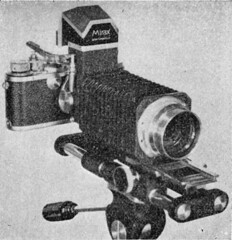 
|

|
| Pre-series prism finder on a Mirax-A (type 8). From Shashin Kōgyō September 1954. (Image rights) | Regular prism finder on a Mirax-A (type 8). From Photo Art no.80, June 1955. (Image rights) |
The production model has a black crinkle finish all over, as on the mirror box. It has a serial number, engraved under the eyepiece, and comes in its own red jewel case, inscribed MIRAX and EYE-LEVEL VIEWFINDER with the company name. Confirmed serial numbers have six digits: the lowest one is 543104, and all others are concentrated in the 5510xx range, from 551007 to 551057. The total production of the item was certainly low.
Waist-level
The waist-level finder is little known, and does not appear in the original documents found so far. It consists of a mere rectangular tube diagonally cut at the top, with no magnifying lens. At first glance, it might look like someone sawed off a regular loupe finder, but various examples have been observed and this was certainly an original part, probably offered towards the end of production.
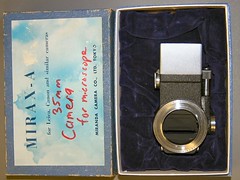 
|
| Mirax-A (type 10-2) with waist-level finder. Pictures by Sunil Gopalan. (Image rights) |
Accessories
The Mirax was part of a system also comprising the Focabell bellows and the Supreme 10.5cm f/2.8 lens head or focusing mount lens.
Adapters and tubes

|

|
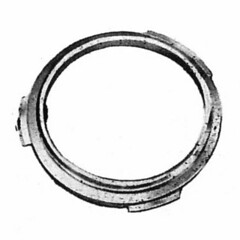
|
| Adapter for Visoflex lenses. | Adapter for Contax standard lenses. | Adapter for Contax tele lenses. |
| From a Mirax brochure. (Image rights) | ||
Various adapters were available from the start,[18] using the 44mm screw thread. The LM adapter (#571) takes screw mount Visoflex lenses, and the RK adapter (#572) takes Reflex-Korelle lenses.[19][1] Both are presumably usable at infinity, at least on the Mirax-A which has the shortest film-to-flange distance. Other adapters were usable at short distance only: the L-L is for Leica screw lenses, the C-S (#573) for Contax or Nikon standard lenses (internal bayonet), and the C-T (#574) for Contax or Nikon tele lenses (external bayonet).[1][20] It seems that the L-L was supplied as standard, at least with the Mirax-A.[21]
Helical rings were made for the Leitz Hektor 135mm and Elmar 90mm lens heads (#1500 and 1520).[1] These are not mentioned in the earliest documents, and were perhaps introduced around 1953.[22] The HM adapter was added later (c.1954) to use these heads on the Focabell, with no focusing helical.[20]
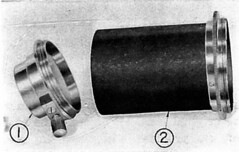
|

|
| Microscope adapter, in two parts. From the Mirax user manual. (Image rights) |
Microscope adapter, hinged version. From a Mirax brochure. (Image rights) |

|
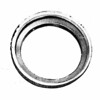
|

|
| Adapter for use on the Exakta. | Adapter for use on the Visoflex. | Extension tubes. |
| From various Mirax brochures. (Image rights) | ||
There was also a microscope adapter. One version is made of two parts, taking the microscope eyepiece between the two.[23] Another version (#580) is hinged at the front, surely for the same purpose.[1] Adapter rings were offered to use the microscope adapter and other items in Mirax screw mount on the Visoflex (#575) or on the Exakta (M-E adapter, #1020).[1][20]
More adapters were probably added afterwards, and all those made for the Miranda bayonet would fit on the Mirax type 7 and later. Orion was also making adapters to mount Leica screw lenses on C-mount or D-mount cine cameras, therefore allowing to attach the Mirax-A on these too.[24]
A set of three extension tubes was offered (#2010),[1] measuring 8mm, 16mm and 32mm,[25] costing ¥2,000 in 1955.[26]
Release attachments
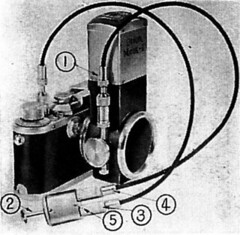 
|
| Mirax-A, early (type 1 or 2), with the older double release or snap release. From the Mirax user manual. (Image rights) |

|
| Older release attachments: single release, double release and snap release. From the Mirax user manual. (Image rights) |
Various release attachments were made. Early documents mention a "single release", a "double release", and a "snap release".[27] The double release is adjustable; the early version is thin and quite long. The snap release consists of a metal plate connecting the release button of the camera body and reflex housing, and fits the early Mirax-A only (types 1 to 7) — it does not fit Nikon or Contax cameras. It has a cap at one end, covering the release button of the mirror box and attached by a tightening screw; the other end is adjustable and stands on the camera's shutter button. There is a finger pad in the middle, whose position can be adjusted and locked by a set screw. It should be placed closer to the mirror actuator than to the shutter button, to insure that the mirror is raised before the shutter is tripped.
Some brief allusions are sometimes made to a cable connecting the bottom thread of the early mirror actuator (types 1 to 7) to the camera's release button, but no picture has been found, and it is not known if this cable was effectively provided by Orion.

|
| Double release, newer model (for Leica and Nikon). From a Mirax brochure. (Image rights) |
The double release was modified around 1953. The new model (catalogue number 590) is shorter and more robust. It is engraved Orion Camera Co., and an engraved line indicates the side that should be attached to the Mirax.[28] It exists in two versions, called type L.N (for Leica or Nikon) and type C (for Contax).[26] The double release for the Mirroscope is quite similar, but has no engraving and has a few detail differences.
 
|
| Mirax-A, intermediate (type 8), with the newer double release or snap release. From a Mirax brochure. (Image rights) |
The snap release was modified in 1954, for the Mirax type 8 and later. The new model is articulated, and fits the bayonet attachment around the release button of the intermediate and late mirror boxes. It is known in three different versions, for Leica, Nikon and Contax bodies. Those for the Leica and Nikon have a bell-shaped part screwed around the camera's shutter button; they only differ by the height of this part. That for the Contax has a conical screw that fits into the center of the Contax shutter button.
Original boxes
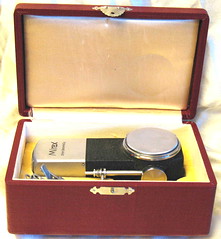  
|
| Mirax-B, intermediate (type 8), no.540524, with jewel case. Pictures courtesy of eBayer toolchest. (Image rights) |
The Mirax was originally supplied with the loupe finder, a release coupler and front and rear caps, in a beautiful red jewel case, whose lid is inscribed MIRAX-A or MIRAX-B with the company name, and which is contained within an outer dark red cardboard box. Late examples were sold in a less glamorous medium blue cardboard box, with clouds drawn on the top cover, marked MIRAX-A for Leica, Canon and similar cameras and MIRANDA CAMERA CO., LTD. TOKYO.[29]
Features and usage as described by Ogihara Akira

|
| Mirax-A and Leica camera on a repro stand. From the Mirax user manual. (Image rights) |
The Mirax was described by Ogihara Akira (荻原彰), founder of Orion Seiki, in the June 1952 issue of Shashin Kōgyō.[30] The article says that the device was developed with the following specifications in mind:[10]
- short length;
- small volume;
- light weight;
- release button usable while holding the camera with both hands;
- viewing screen at least as bright as that of the Exakta;
- interchangeable prism and ordinary finders.
Point no.6 eliminates the need for a rotating mirror box for vertical pictures, helping to concentrate on the first four features.[10]
The article emphasizes the device's short length and light weight. The Mirax-A and Mirax-B are respectively 40mm and 43mm thick; this was much less than the contemporary Leitz Visoflex I reflex housing, and potentially allowed the use of 75mm or 80mm lenses.[10][31] The weight is respectively 200g (or 220g) and 250g.[32] Ogihara suggests that the Mirax can be used without a tripod, and describes four release methods, depending on the photographer's needs:[18]
- trip the mirror box first, then the camera, to avoid blur for scientific applications;
- use a dual cable release, convenient when the camera is on a tripod;
- use a cable coupling the bottom part of the release rod to the camera's shutter button, allowing to hold the camera in both hands;
- use the "Snap release" provided with the Mirax, for hand-held operation.
The third method is only valid on the early Mirax types, which have a connecting thread protruding underneath the mirror mechanism, and is no longer possible on the intermediate and late models.
| Mirax-A, very early (type 1), on a Leica IIIb. From Shashin Kōgyō June 1952. (Image rights) | ||
| With a Supreme-A 10.5cm f/2.8 lens and a loupe or eye-level finder. | With an Olympus microscope. | |
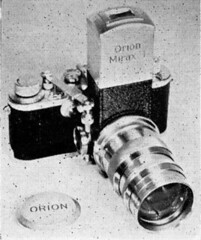
|
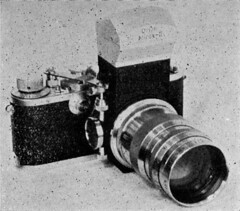
|

|
When the article was published in June 1952, the Supreme 10.5cm f/2.8 focusing mount lens was already in production, as well as various adapters (see above).[18] Ogihara also mentions a bellows system under development;[18] this would later appear as the Focabell.
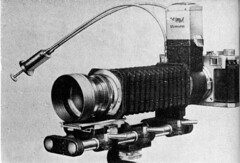
|
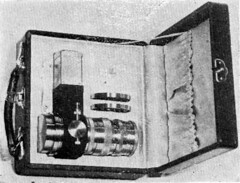
|
| Mirax-B, Focabell and Supreme-C 10.5cm f/2.8 lens head, on a Nikon S. | Mirax-B and Supreme-B 10.5cm f/2.8. |
| From Shashin Kōgyō May 1953. (Image rights) | |
Another article by Ogihara appears in the May 1953 issue of the same magazine, with very similar contents.[33] The document shows the Focabell bellows and Supreme-C 10.5cm f/2.8 lens head. It says that the first type of prism finder was abandoned because the position of the eyepiece was impractical, and that a new type of pentaprism was being developed.[34] In addition to the 10.5cm f/2.8, a specific 75/3.5 lens is mentioned as under development.[34] Ogihara also says that there were demands for a retrofocus 50mm lens, but he would reject these because the rangefinder camera body alone is better suited for standard lenses.[34]
Commercial life and original documents
Earliest documents, c.1952
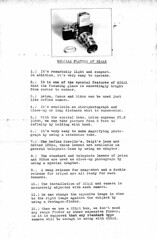
|
| Typewritten document on the Mirax, c.1952. Scan by Jeffrey Felton. (Image rights) |

|
| Mirax-A, very early (type 1), and Supreme-A 10.5cm f/2.8 lens no.510808, on a Leica IIIb. This photograph was attached to the typewritten document on the right. Scan by Jeffrey Felton. (Image rights) |
The Mirax was certainly already available when Ogihara wrote the article cited above in Shashin Kōgyō June 1952. The earliest document issued by Orion Seiki known so far is a carbon-copied typewritten list of features in English language, with a photograph glued at the top,[35] the same as in the 1952 article by Ogihara. It briefly mentions the pentaprism finder, extension tubes and adapters for Reflex-Korelle, Telyt and Hektor 135mm lenses (at infinity), and for Leica and Nikon-mount lenses (for close-ups).
Instruction manuals, c.1953
    
|
    
|
| Mirax instruction manual, English language. Scans by Jeffrey Felton. (Image rights) |
The English instruction manual for the Mirax reproduced above mentions Orion Camera Co., Ltd. and the distributor Summit Camera Co., Ltd. It was certainly printed c.1953. The pictures show early examples of the Mirax-A and B (types 2 and 3), and are similar to those in Ogihara's article dated May 1953.
    
|
    
|
| Mirroscope instruction manual, English language. Scans by Jeffrey Felton. (Image rights) |
An exactly similar instruction manual was printed for the Mirroscope (reproduced above). The company names were replaced by that of Interstate Photo Supply Corp. The word "Mirax" was replaced by "Mirroscope" throughout the text, and the pictures were simply retouched. The document therefore mentions a Mirroscope B for Contax and Nikon, but no example of it has yet been found.
Documents by The Focus, N.Y.
      
|
| Catalogue by The Focus. Scans by Jeffrey Felton. (Image rights) |

|
| Leaflet by The Focus, for the Variflex. Scan by Jeffrey Felton. (Image rights) |
The Mirroscope reflex housing and prism finder were advertised at the same time by The Focus,[7] an obscure company based in New York, which was perhaps founded specially for the purpose. In the above catalogue, the two items are listed respectively under the names "The Focus mirror reflex housing" (FRH-1) and "eyelevel viewer" (EL-5), normally priced at $69.50 and $20.00, and offered at the "promotional introductory price" of $39.83 and $14.75.
The lenses offered in the catalogue are the German-made Doryt 105/4.5 (DL-15) and Actinar 135/4.5 (AL-12), and the Schneider Tele-Xenar 240/5.5 (XTL-24). Various accessories are listed: a "variable focusing mount" (FT-2), a set of three extension tubes, measuring 5mm, 15mm and 30mm (T-10), a bellows (BF-22), an adapter for Hektor lens head (AH-3), a twin release cable (TW-6) and a microscope adapter (MA-4). The variable focusing mount, visible in the catalogue picture, has a Leica thread mount at both ends, and is used on the reflex housing via an adapter. It is likely that all the other items are generic accessories in Leica thread mount, and that none was made by Orion. The picture shows the reflex housing with the prism finder, variable focusing mount and Actinar lens head. The name MIRROSCOPE seems to appear above the prism finder.
The leaflet on the right, printed by the same company, advertises the Variflex set, comprising the reflex housing, bellows and Actinar 135/4.5 lens head, priced at $99.50.[6] The single-rail bellows is certainly the BF-22 mentioned in the catalogue, and was definitely not made by Orion.
Japanese documents, c.1953
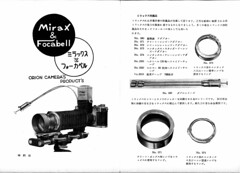 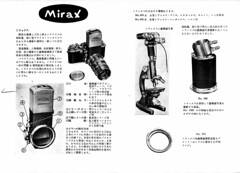
|
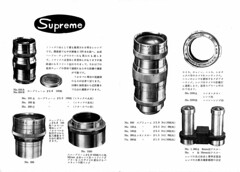 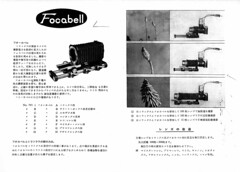
|
| Brochure for the Mirax, Focabell and Supreme, c.1953. Scans by Jeffrey Felton. (Image rights) |
The above Japanese brochure, dated about 1953, shows the early Mirax (types 1 or 2 and 3 or 4), and lists a number of accessories.[28] It gives various catalogue numbers, which are otherwise unheard of.
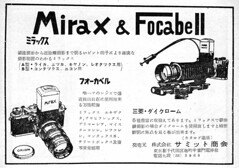
|
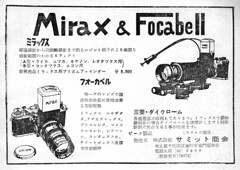
|
| September 1953. | October and November 1953. |
| Advertisements by Summit Shōkai in Asahi Camera. (Image rights) | |
Advertisements by the distributor Summit Shōkai appear in the September to November 1953 issues of Asahi Camera.[36] They are nearly identical, except for the addition of the prism finder from October, priced at ¥6,500 and mentioned as a new item. No picture of the prism is provided — it might correspond to the first version announced in 1952, but this is unsure.
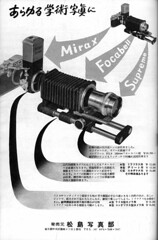
|
| Advertisement by Matsushima in Asahi Camera November 1953. (Image rights) |
In addition to the advertisement by Summit, the November 1953 issue of Asahi Camera also contains an advertisement by Matsushima,[37] apparently indicating that Orion changed its main distributor at that time. The document shows the early version of the Mirax-A, and gives the price of ¥15,200 for the model A and ¥19,800 for the model B.

|
| Announcement of the prism finder in Shashin Kōgyō September 1954. (Image rights) |
After Matsushima became the main distributor of the Mirax, the company Summit Shōkai may have continued to distribute the reflex housing under the alternative name Mirabox. At least one advertisement by Summit is known to list a Mirabox A for ¥13,000, a Mirabox B for ¥19,700, and a pentaprism finder for ¥7,500.[38] (No example of the Mirabox B has yet been observed.)
Intermediate period, 1954–5
The article by Ogihara in Shashin Kōgyō May 1954 is the earliest document to show the intermediate Mirax model (type 8), paired with a prototype prism finder (see above).[39] The September 1954 issue of the same magazine contains an announcement for the prism finder, showing a pre-series example mounted on an intermediate Mirax-A (type 8).[40] The price of the prism is set at ¥9,000.
The brochure reproduced below was printed at the same period.[21] It is perhaps the earliest document to show a picture of the production prism finder.

|
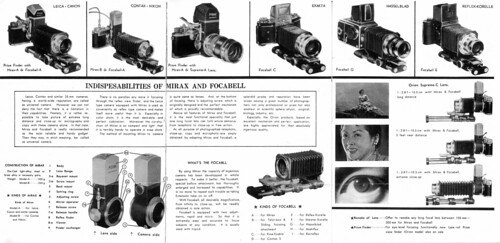
|
| Brochure for the Mirax, Focabell and Supreme, c.1954. Scans by Jeffrey Felton. (Image rights) |
Matsushima continued to distribute the Mirax for many years. In 1955, advertisements appear in various issues of Asahi Camera, from January to April and again in August.[41] The picture or drawing shows the intermediate Mirax-A with pre-series prism finder.
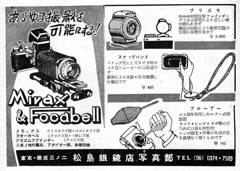
|
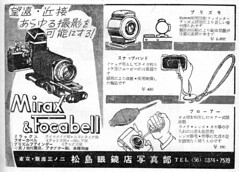
|
| January, February and August 1955. | March 1955. |

| |
| April 1955. | |
| Advertisements by Matsushima in Asahi Camera. (Image rights) | |

|
| Advertisement by Matsushima in the June 1955 special issue of Photo Art. (Image rights) |
The June 1955 special issue of Photo Art contains a full-page advertisement by Matsushima.[42] It gives the name of the manufacturer Orion Seiki, unlike the previous advertisements. The prices are the same as in 1953 (except for the prism). The microscope adapter is also mentioned at ¥3,500.
The same issue of the magazine, entirely devoted to camera accessories, describes the Mirax in two places, and gives a price list. The prices are the same as in the advertisement, but the document distinguishes between the Mirax-BC (for Contax) and the Mirax-Bn (for Nikon), as said above. Other minor accessories are listed: the double release type L.N or type C, at ¥1,800, and the extension tube, at ¥2,000. The document also presents the Focabell bellows system and Supreme lenses.

|
| Column in the June 1955 special issue of Photo Art. (Image rights) |
After the Miranda SLR
The Mirax was continued for some years after the introduction of the Miranda. The device was still in production when the company changed its name from Orion Camera to Miranda Camera in 1957, as indicated by the markings observed on actual examples. Advertisements showing the Mirax were placed by Matsushima in Japanese magazines dated April to July 1958 (reproduced below).[43] The device is also pictured in an advertisement for the Miranda B, placed by Miranda Camera in Asahi Camera February 1959, shortly before the products of the company ceased to be distributed in Japan.[44]

|
| Advertisement in Shashin Kōgyō April 1958. (Image rights) |
 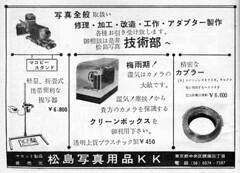
|
| Advertisements in Asahi Camera May and July 1958. (Image rights) |
Notes
- ↑ 1.0 1.1 1.2 1.3 1.4 1.5 1.6 1.7 Catalogue numbers: brochure Mirax & Focabell, Orion Camera's Product's.
- ↑ Column in the June 1955 special issue of Photo Art, p.119.
- ↑ The classification of the Mirax variants has been introduced by Jeffrey Felton, who supplied many documents and information for this article.
- ↑ Information provided by Jeffrey Felton. This is confirmed only for Mirax types 1 and 2, but presumably applies to type 3 as well.
- ↑ 5.0 5.1 Ogihara, p.346 of Shashin Kōgyō May 1954.
- ↑ 6.0 6.1 Leaflet by The Focus for the Variflex, c.1953.
- ↑ 7.0 7.1 7.2 Catalogue by The Focus, c.1953.
- ↑ The examples pictured in the June 1955 special issue of Photo Art, pp.22 and 120, correspond to type 7.
- ↑ Example sold as lot no.366 of Westlicht auction no.9 (May 20, 2006); see the links below.
- ↑ 10.0 10.1 10.2 10.3 Ogihara, p.26 of Shashin Kōgyō no.1.
- ↑ English user manual Photography with Mirax, p.12.
- ↑ Ogihara, p.277 of Shashin Kōgyō May 1953.
- ↑ Ogihara, p.27 of Shashin Kōgyō no.1; English user manual Photography with Mirax, p.12; user manual of the Miranda dx-3, p.2, available in PDF format at butkus.org.
- ↑ Ogihara, p.345 of Shashin Kōgyō May 1954, says that "when extending the eyepiece to the rear, the magnification of the optical element is lowered and the image becomes too small and hard to see": アイ・ピースを[...]後に引くと、それだけ拡大鏡の倍率が下り、像が小さくなって見にくい. This might be an allusion to the design of the Mirroscope prism finder.
- ↑ Example observed in an online auction.
- ↑ Ogihara, pp.344–5 of Shashin Kōgyō May 1954.
- ↑ Column in Shashin Kōgyō September 1954, p.197.
- ↑ 18.0 18.1 18.2 18.3 Ogihara, p.27 of Shashin Kōgyō no.1.
- ↑ The names LM and RK appear in the English user manual Photography with Mirax, p.13.
- ↑ 20.0 20.1 20.2 Adapter names: brochure Reflex Box for Copy, Close-up, Micro and Tele-photography: Mirax & Focabell.
- ↑ 21.0 21.1 Brochure Reflex Box for Copy, Close-up, Micro and Tele-photography: Mirax & Focabell.
- ↑ The helical rings are not mentioned in Ogihara, pp.26–7 of Shashin Kōgyō June 1952.
- ↑ English user manual Photography with Mirax, p.4.
- ↑ Advertisement in the June 1955 special issue of Photo Art, p.22.
- ↑ English user manual Photography with Mirax, p.8.
- ↑ 26.0 26.1 Price list in the June 1955 special issue of Photo Art, p.119.
- ↑ English user manual Photography with Mirax, pp.9–11.
- ↑ 28.0 28.1 Brochure Mirax & Focabell, Orion Camera's Product's.
- ↑ Box observed in an online auction.
- ↑ Ogihara, pp.26–7 of Shashin Kōgyō no.1.
- ↑ This is repeated in the English user manual Photography with Mirax, p.13.
- ↑ Ogihara, p.27 of Shashin Kōgyō June 1952, says 200g for the Mirax-A, but other articles by the same author in Shashin Kōgyō May 1953 and May 1954 say 220g instead.
- ↑ Ogihara, pp.275–7 of Shashin Kōgyō May 1953.
- ↑ 34.0 34.1 34.2 Ogihara, p.277 of Shashin Kōgyō May 1953.
- ↑ Typewritten sheet Special features of Mirax, c.1952.
- ↑ Advertisements in Asahi Camera September 1953 (p.190), October 1953 (p.217) and November 1953 (p.194).
- ↑ Advertisement in Asahi Camera November 1953 (p.59).
- ↑ Advertisement communicated by Jeffrey Felton, date unknown.
- ↑ Ogihara, pp.344–8 of Shashin Kōgyō May 1954.
- ↑ Column in Shashin Kōgyō September 1954, p.197.
- ↑ Advertisement in Asahi Camera January 1955, p.229, February 1955, p.190, March 1955, p.180, April 1955, p.211, and August 1955, p.206.
- ↑ Advertisement in the June 1955 special issue of Photo Art, p.22.
- ↑ Advertisement in Shashin Kōgyō April 1958, p.317; advertisements in Asahi Camera May 1958, p.221, and July 1958, p.213.
- ↑ Advertisement reproduced in Kokusan kamera no rekishi, p.306.
Bibliography
Original documents
- Asahi Camera. Advertisements by Summit Shōkai:
- September 1953, p.190;
- October 1953, p.217;
- November 1953, p.194.
- Asahi Camera. Advertisements by the photo department of Matsushima or Matsushima Megane-ten:
- November 1953, p.59;
- January 1955, p.229;
- February 1955, p.190;
- March 1955, p.180;
- April 1955, p.211;
- August 1955, p.206.
- Asahi Camera. Advertisements by Matsushima Shashin-yōhin:
- May 1958, p.221;
- July 1958, p.213.
- The Focus. The Focus Single Lens Reflex System for the Leica. Catalogue in English language, c.1953.
- The Focus. Variflex. Leaflet in English language, c.1953.
- Interstate Photo Supply Corp. Photography with Mirroscope. Instruction manual, English language, c.1953–4.
- Ogihara Akira (荻原彰). "Mirakkusu ni tsuite" (ミラックスについて, About the Mirax). In Shashin Kōgyō no.1, June 1952. Pp.26–7.
- Ogihara Akira (荻原彰). "Mirakkusu no kōzō to tokusei" (ミラックスの構造と特性, Construction and special features of the Mirax). In Shashin Kōgyō no.12, May 1953. Pp.275–7.
- Ogihara Akira (荻原彰). "Mirakkusu to Fōkaberu ni tsuite" (ミラックスとフォーカベルについて, On the Mirax and Focabell). In Shashin Kōgyō no.24, May 1954. Pp.344–8.
- Orion Seiki (presumably). Special features of Mirax. Typewritten sheet, English language, c.1952.
- Orion Camera Co., Ltd. and Summit Camera Co., Ltd. Photography with Mirax. Instruction manual, English language, c.1953.
- Orion Camera. Mirax & Focabell, Orion Camera's Product's. (ミラックスとフォーカベル, Orion Camera's product's.) Brochure in Japanese language, c.1953.
- Orion Camera. Reflex Box for Copy, Close-up, Micro and Tele-photography: Mirax & Focabell. Brochure in English language, c.1954.
- Photo Art rinji zōkan: Kamera akusesarī zensho (フォトアート臨時増刊・カメラアクセサリー全書, Photo Art special issue: All the camera accessories). June 1955, no.80 of the magazine.
- Advertisement by the photo department of Matsushima Megane-ten on p.22.
- "Zukai: Akusesarī no mekanikku. 12: Bōen, sessha, fukusha sōchi. Mirakkusu to Fōkaberu." (図解・アクセサリーのメカニック・12・望遠・接写・複写装置・ミラックスとフォーカベル. Drawings: accessory mechanisms. 12: Telephoto, close-up and reproduction devices. Mirax and Focabell.) P.51.
- "Shashin no kaimi wa sessha to bōen satsuei kara: Purokusā, Ōtoappu, Refubokkusu, sonota." (写真の快味は接写と望遠撮影から・プロクサー・オートアップ・レフボックス・その他, Because the appeal of photography comes with close-up and telephoto pictures: Proxar, Auto-Up, reflex housing, etc.) Pp.118–20.
- Photo Art rinji zōkan: Kamera no chishiki (フォトアート臨時増刊・カメラの知識, Photo Art special issue: Knowledge of cameras). October 1955, no.87 of the magazine. "Kakubu no kikō to sono sōsa. 14: Kamera ni toritsukeru akusesarī no chishiki. Renzu zenmen ni. b: Hojo satsuei kigu, renzu." (各部の機構とその操作・14・カメラに取付けるアクセサリーの知識・レンズ前面に・b・補助撮影器具・レンズ. Mechanism and operation of all the parts. 14: Knowledge of the accessories attached to the camera. In front of the lens. b: Accessory photographic instruments, lenses.) P.47. (Short mention only, with two small pictures.)
- Shashin Kōgyō no.28, September 1954. "Shashin Kōgyō Nyūsu" (写真工業ニュース, Photographic Industry News). P.197.
- Shashin Kōgyō no.72, April 1958. Advertisement by Matsushima Shashin-yōhin on p.317.
Recent sources
- Asahi Camera (アサヒカメラ) editorial staff. Shōwa 10–40nen kōkoku ni miru kokusan kamera no rekishi (昭和10–40年広告にみる国産カメラの歴史, Japanese camera history as seen in advertisements, 1935–1965). Tokyo: Asahi Shinbunsha, 1994. ISBN 4-02-330312-7. Advertisement for item 1676.
- Hagiya Takeshi (萩谷剛). "Miranda Sutōrī" (ミランダ・ストーリー, Miranda story). In Kamera Rebyū: Kurashikku Kamera Senka (カメラレビュー クラシックカメラ専科) / Camera Review: All about Historical Cameras no.64, June 2002. ISBN 4-257-13048-2. Miranda no keifu (ミランダの系譜, Miranda genealogy). Pp.9–12.
- "Miranda akusesarī" (ミランダ・アクセサリー, Miranda accessories). In Kamera Rebyū: Kurashikku Kamera Senka (カメラレビュー クラシックカメラ専科) / Camera Review: All about Historical Cameras no.64, June 2002. ISBN 4-257-13048-2. Miranda no keifu (ミランダの系譜, Miranda genealogy). Pp.44–5.
- Miranda Camera Co., Ltd. Owner's manual of the Miranda dx-3. Contains pictures of the Mirax on p.2. Available in PDF format at butkus.org. (See the remarks on this document in the bibliography section of the Miranda page.)
Links
In English:
- Pages of the Miranda Historical Society (archived):
- Mirax housings
- Focabell bellows system
- Mirax and Focabell among rare items
- Past sales by Westlicht Photographica Auction (now Leitz Photographica Auction):
- Orion Camera Mirax-A with Supreme 10.5cm f/2.8 lens, sold as lot no.365 of the ninth auction (May 20, 2006)
- Orion Camera Mirax-A with Supreme 10.5cm f/2.8 lens, sold as lot no.398 of the fourteenth auction (November 30, 2008)
- Miranda Camera Mirax-A and accessories (two examples with consecutive numbers), sold as lot no.366 of the ninth auction (May 20, 2006)
- Interstate Mirroscope for Leica, with adapter for Exakta lenses, sold as lot no.232 of the thirteenth auction (June 7, 2008)
- Mirax-A on a Nikkor 25cm f/4 at Cameraquest
In Japanese:
- Text-only details on the Mirax among telephoto lenses at the Miranda Society Japan